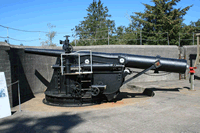 |
|
|
 |
 |
 |
|
Japanese Invasion
On June 21, 1942 the Pacific Fleet was severely damaged with a single blow the from Japanese. Our sense of national security evaporated. All of a sudden the possibility of an attack on the West Coast seemed both real and imminent.
 The morning after Pearl Harbor, a meeting in Washington D.C. discussed the situation on the West Coast. The lack of weapons and protection were talked about and direct measures were taken to fix the situation. One hundred fighter planes that were being sent to England were seized along with a shipload of anti-aircraft guns and were all sent to the west coast. There were originally a little over a hundred officers at the coast, by December 9th there were 31,000 with more coming in at all times. The morning after Pearl Harbor, a meeting in Washington D.C. discussed the situation on the West Coast. The lack of weapons and protection were talked about and direct measures were taken to fix the situation. One hundred fighter planes that were being sent to England were seized along with a shipload of anti-aircraft guns and were all sent to the west coast. There were originally a little over a hundred officers at the coast, by December 9th there were 31,000 with more coming in at all times.
 Although many protective measures were made to secure the coast from a Japanese attack, on the night of June 21, 1941 around 11:30 pm a Japanese submarine attacked Ft. Stevens. The submarine lobbed 17 shells toward Ft. Stevens in a twenty-minute bombardment. Most of the shells landed in swampy terrain, one did fall 300 yards in front of Battery Russell and one within 50 yards of a concrete pillbox. No damage was done, but this was the only bombardment of a fortification within the continental U.S. since 1812. Although many protective measures were made to secure the coast from a Japanese attack, on the night of June 21, 1941 around 11:30 pm a Japanese submarine attacked Ft. Stevens. The submarine lobbed 17 shells toward Ft. Stevens in a twenty-minute bombardment. Most of the shells landed in swampy terrain, one did fall 300 yards in front of Battery Russell and one within 50 yards of a concrete pillbox. No damage was done, but this was the only bombardment of a fortification within the continental U.S. since 1812.
After this attack the conclusion was made that the fort's weapons were poorly out dated. Modernization efforts were initiated with construction of new batteries and inactivation of older outdated ones.
|
|
 |
|
|
 |

